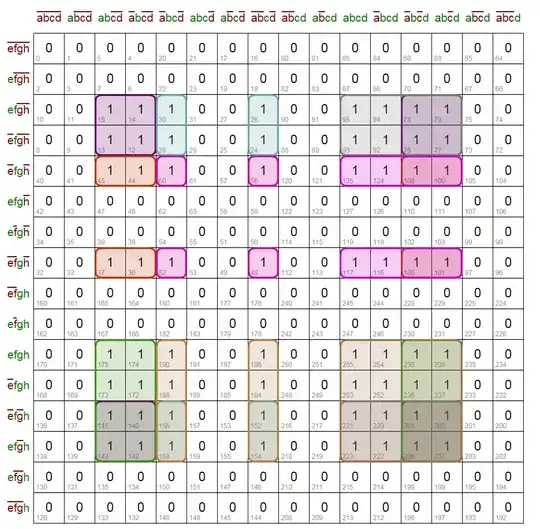I'm reaching back into my high school days trying to remember one of the rules about Karnaugh Maps. I have an 8 variable input, and I remember that I should try and make the selections a big as possible. However, I vaguely remember that if I have a selection, that the number of $1$'s for a variable must equal the number of $0$'s for the same variable if it is to cancel out.
When dealing with 4 variable tables, this is not a problem, but when I move to 8, I can get a single selection that has columns $0010$, $0110$, $0111$, $0101$, $0100$, $1100$, $1101$ and $1111$ selected.
As you can see, the bit 3 (msb) has 5 $0$s and 3 $1$s, bit 2 has 1 $0$s and 7 $1$s, bit 1 and 0 have 4 of each. My questions are:
- Is this a valid single selection?
- If this is a valid single selection, how do I handle it?
- If not a valid single selection, why not? What are the rules that stipulate what a valid single selection is? What is the meaning behind those rules?
I understand that when a bit is constant, it is used. When there are equal numbers of $1$s and $0$s, they cancel each other out. So what is done when there unequal number of $1$s and $0$s?
EDIT
For those of you who didn't understand what I was talking about, here is a 8 variable Karnaugh map:
The top header shows the numeric and the symbol representation of the values. I've not done the same for the left side header, but assume that they represent 4 other independent variables E, F, G, and H, though it is really irrelevenat.
Assume that all that are marked $1$ are true values and those not marked are false.
The $1$'s represent an 8x8 selection matrix, which by my understanding is a valid selection. Note that this could easily be an 8x1, 8x2, 8x4, 8x8 or 8x16 matrix located as a single grouping anywhere in the column specified. This is just an example.

